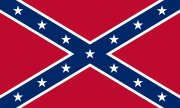States' Rights Democratic Party (Dixiecrats) | |
|---|---|
| Leader | Strom Thurmond |
| Founded | 1948 |
| Dissolved | 1948 |
| Split from | Democratic Party |
| Merged into | Democratic Party |
| Ideology | |
| Colors | Red, white, blue (official) |
| Party flag (de facto)[1][2][3] | |
 | |
The States' Rights Democratic Party (whose members are often called the Dixiecrats), also colloquially referred to as the Dixiecrat Party was a short-lived segregationist political party in the United States, active primarily in the South. It arose due to a Southern regional split in opposition to the national Democratic Party. After President Harry S. Truman, the leader of the Democratic Party, ordered integration of the military in 1948 and other actions to address civil rights of African Americans, including the first presidential proposal for comprehensive civil and voting rights, many Southern white politicians who objected to this course organized themselves as a breakaway faction. They wished to protect the ability of states to maintain racial segregation.[4] Its members were referred to as "Dixiecrats", a portmanteau of "Dixie", referring to the Southern United States, and "Democrat".
In the 1930s, a political realignment occurred largely due to the New Deal policies of President Franklin D. Roosevelt. While many Democrats in the South supported substantive economic intervention, civil rights for African Americans were not specifically incorporated within the New Deal agenda, due in part to Southern control over many key positions of power within the U.S. Congress.[5] Supporters assumed control of the state Democratic parties in part or in full in several Southern states. They opposed racial integration and wanted to retain Jim Crow laws and other aspects of de jure and de facto racial discrimination. On non-racial issues, they held heterogeneous beliefs. Despite the Dixiecrats' success in several states, Truman was narrowly re-elected. After the 1948 election, its leaders generally returned to the Democratic Party, at least for a time, although the Dixiecrats weakened Democratic identity among white Southerners. The Dixiecrats' standard bearer, Senator Strom Thurmond of South Carolina, eventually switched to the Republican Party in 1964.[6]
- ^ Costa-Roberts, Daniel (June 21, 2015), "8 things you didn't know about the Confederate flag", PBS NewsHour website, archived from the original on September 7, 2022, retrieved September 7, 2022,
In 1948, the newly-formed segregationist Dixiecrat party adopted the flag as a symbol of resistance to the federal government.
- ^ Taylor, Jessica (June 22, 2015), "The Complicated Political History Of The Confederate Flag", NPR website, archived from the original on January 25, 2022, retrieved September 7, 2022,
After the war ended, the symbol became a source of Southern pride and heritage, as well as a remembrance of Confederate soldiers who died in battle. But as racism and segregation gripped the nation in the century following, it became a divisive and violent emblem of the Ku Klux Klan and white supremacist groups. It was also the symbol of the States' Rights Democratic Party, or "Dixiecrats," that formed in 1948 to oppose civil-rights platforms of the Democratic Party.
- ^ Frederickson 2001, pp. 173–174The adoption of the flag as the unofficial party symbol sparked considerable debate. Ralph McGill spoke out against southerners who “prostitute the Confederate Flag and the song ‘Dixie’ to their own uses.”
- ^ Lemmon, Sarah McCulloh (December 1951). "The Ideology of the 'Dixiecrat' Movement". Social Forces. 30 (2): 162–71. doi:10.2307/2571628. JSTOR 2571628.
- ^ Lung-Amam, Willow (January 18, 2021). "The Next New Deal Must Be for Black Americans, Too". Bloomberg News. Retrieved February 17, 2023.
- ^ Bibby, John F.; Maisel, L. Sandy (April 9, 1998). Two Parties--or More?: The American Party System. Avalon Publishing. p. 35. ISBN 978-0-8133-9993-5. Retrieved April 24, 2023.